Volkswagen Amarok review (2025)
The latest Volkswagen Amarok is plusher, stronger, roomier but so is its main rival
PROS
- Refined pickup truck to drive
- Strong towing and payload ability
- High quality feeling interior
- Good passenger space
- Good on road and off
CONS
- Shares many features with Ford Ranger rival
- No Raptor rivalling performance version
- Infotainment still has some annoying quirks
- More expensive and fewer models than Ranger
- Top trim doesn't qualify as a commercial vehicle
Summary
The Volkswagen Amarok has traditionally won over buyers who want to combine the utility of the best pickups with a more luxurious, premium feel inside and out. This second-generation model, launched in 2023, continues this approach with aplomb. However, it now shares a vast amount of engineering and technology with arch-rival the Ford Ranger, as the two trucks are among the first fruit of the firms' global alliance to jointly build commercial vehicles.
What's more, since Ford played the lead role in the development of this dual-brand pickup truck - which carries over much of the previous-generation Ford Ranger underneath - many of the components are from other Fords as well. The Amarok's engines and gearboxes, and even the software behind the infotainment system, are all of Ford’s creation.

What makes the latest Volkswagen Amarok a VW?
However, despite Ford’s prominent status in the pickup partnership, Volkswagen says it still played a key role in the Amarok’s creation, and was able to configure the truck in a manner that made it much more than just a photocopy of the Ranger. Aside from the rooftop, mirror housings and door handles, every external element is bespoke to the Amarok, which means that there is little chance of mistaking the two vehicles at a glance.
For us, the result is recognisably a Volkswagen, with elements such as the LED headlights, angular wheel arches and chunky roll bar at the front of the loading bay are all details that will stand out.
Inside there are VW-specific materials and at least bespoke look to the infotainment screen. The configuration extends to how it drives, too, with VW going for a sharper, more responsive steering setup and its own suspension configuration.
There are four trim levels in the UK: Life, Style, PanAmericana and Aventura. The Amarok only comes with a double-cab body, whereas the Ranger is available as a basic Single Cab working truck, too.
What are the VW Amarok’s rivals?
Aside from the Ranger, the Toyota Hilux has great all-round appeal and, with the 2.8-litre diesel, now finally has an engine that befits its status. For this reason and more it won the 2023 Parkers Pickup of the Year award. The Ranger took home that accolade in 2024 and 2025, though.
The Isuzu D-Max is unashamedly a workhorse first and foremost, offering a more rugged interior and a much smaller 1.9-litre diesel. So if you need a no-nonsense working truck with historically proven durability, the D-Max is worth a look. But it can't compete with any of the three major rivals when it comes to luxury or on-road comfort.
Verdict: is the Volkswagen Amarok any good?
In short, yes, the Amarok is very good. But it has lost a little of its previously unique luxury appeal. VW has worked hard to make it recognisably a Volkswagen, but can only do so much when some features are so fundamentally part of what was once a rival.
As such, the Amarok has a fine interior, boasts lots of practicality, and drives very well, but it no longer feels absolutely like a Volkswagen commercial vehicle. This will matter less to pragmatists who just want a comfy working truck with badge kudos, but it might be mourned more by diehard VW fans who see their pickup as an extension of who they are. And while it is still an excellent vehicle, so is the Ranger, and the Ford offers buyers wider choice and greater value.
Skip to our full verdict on...
- Excellent to drive on road
- Strong and capable in the dirt.
- Large, which will impact where you can get off road
There are no major surprises in the Amarok’s engine range. There are a pair of 2.0-litre diesel engines and a 3.0-litre V6 diesel. Both are shared with the Ranger and are Ford engines rather than VW ones, which means that the latter is not a carryover from the previous Amarok, which won plaudits and buyers with its powerful V6 offering.
Despite it being a Ford engine rather than the unit from the predecessor, VW expects the majority of customers to go for the V6. It suits the truck’s laidback but powerful approach. It takes a bit of effort and a hefty blast of accelerator to get it to blast the Amarok up to speed swiftly, but it will do it, with 62mph coming in less than 9.0 seconds.
The 205hp version of the 2.0-litre diesel is the sensible choice in some senses - it is marginally more economical, costs less and still offers the same towing and carrying abilities. But it lacks a little of the effortless oomph that will make dealing with heavy loads, towing and swift overtaking easier. At this price point, the percentage step up to the V6 is not vast, so the latter is where we'd be looking.
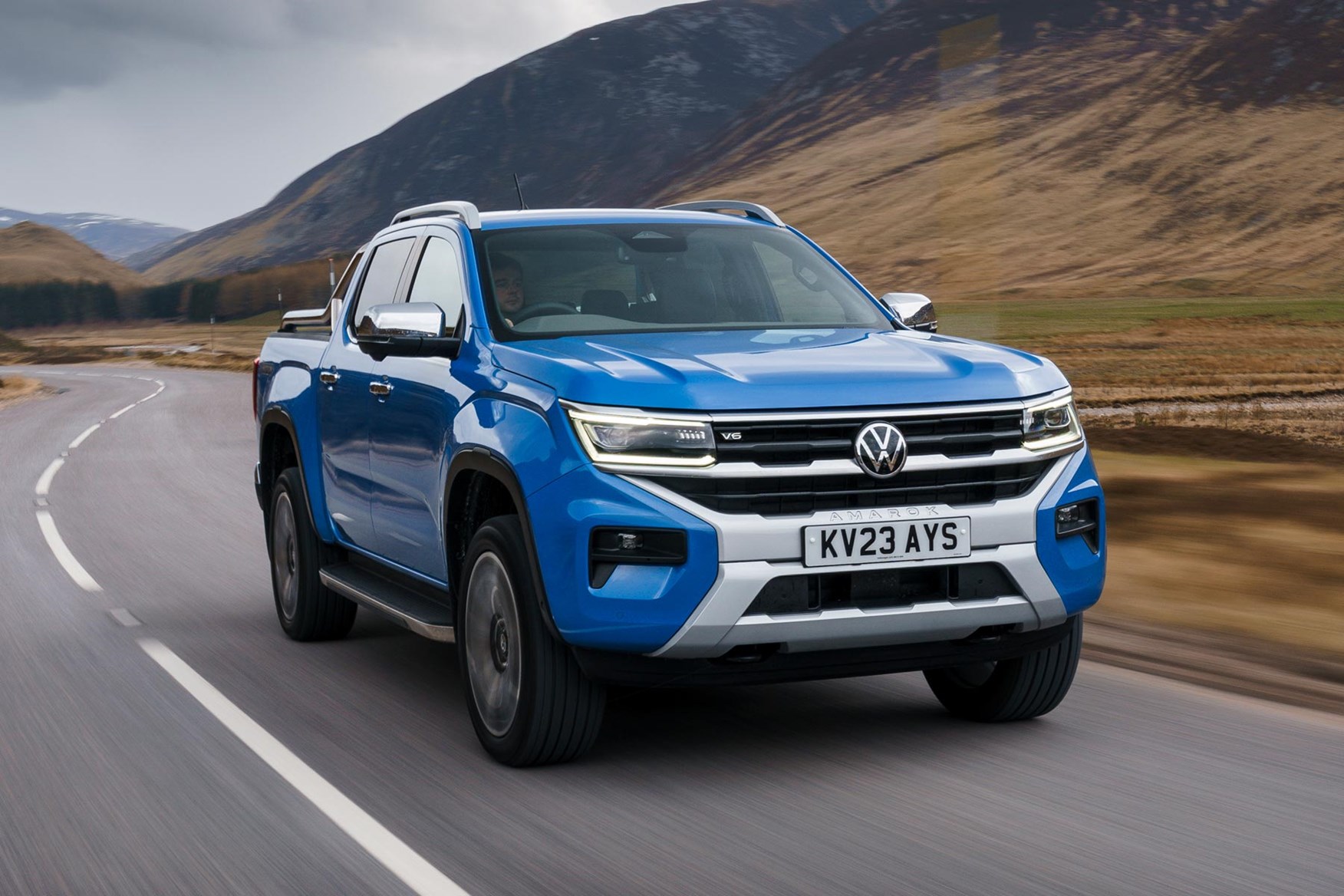
The gearbox offering is biased towards the automatic side of things, with all bar the entry-level 170hp 2.0-litre diesel getting a 10-speed automatic gearbox. We've yet to try the six-speed manual on the entry-level engine, but the 10-speed auto suits the Amarok's nature very well - it's generally laid back, and just smoothly gets on with what you need it to do the majority of the time.
This relaxed nature is summed up by the fact that there are no paddles behind the wheel for shifting gears manually. If you want to do that then you are going to have to use a tiny rocker switch on the side of the gear selector. The 'Up' and 'Down' buttons are very small, though, and sit next to the one that selects manual mode so are hard to hit accurately without looking. It's designed for holding or selecting a low gear while off road rather than blipping down a couple of ratios to blast through a corner or two.
That’s all for now in terms of engine and gearbox combos, although there are mutterings and whispers about alternative powertrains in the future. This truck has been built to be able to take a pure-electric battery and motor, and a plug-in hybrid. The latter would use the petrol engine that is offered in the Amarok in other markets – a four-cylinder 2.3-litre unit. Keen observers might spot that this is the engine that is set to form the basis of the forthcoming Ford Transit Custom plug-in hybrid.
What is the VW Amarok's ride and handling like?
The Amarok has always been an excellent pickup to drive, and thankfully the 2023 version continues this long-standing tradition. This is one area where the VW engineers have been allowed to stamp their own mark on the truck, having been able to set up both steering and suspension to their own configuration.
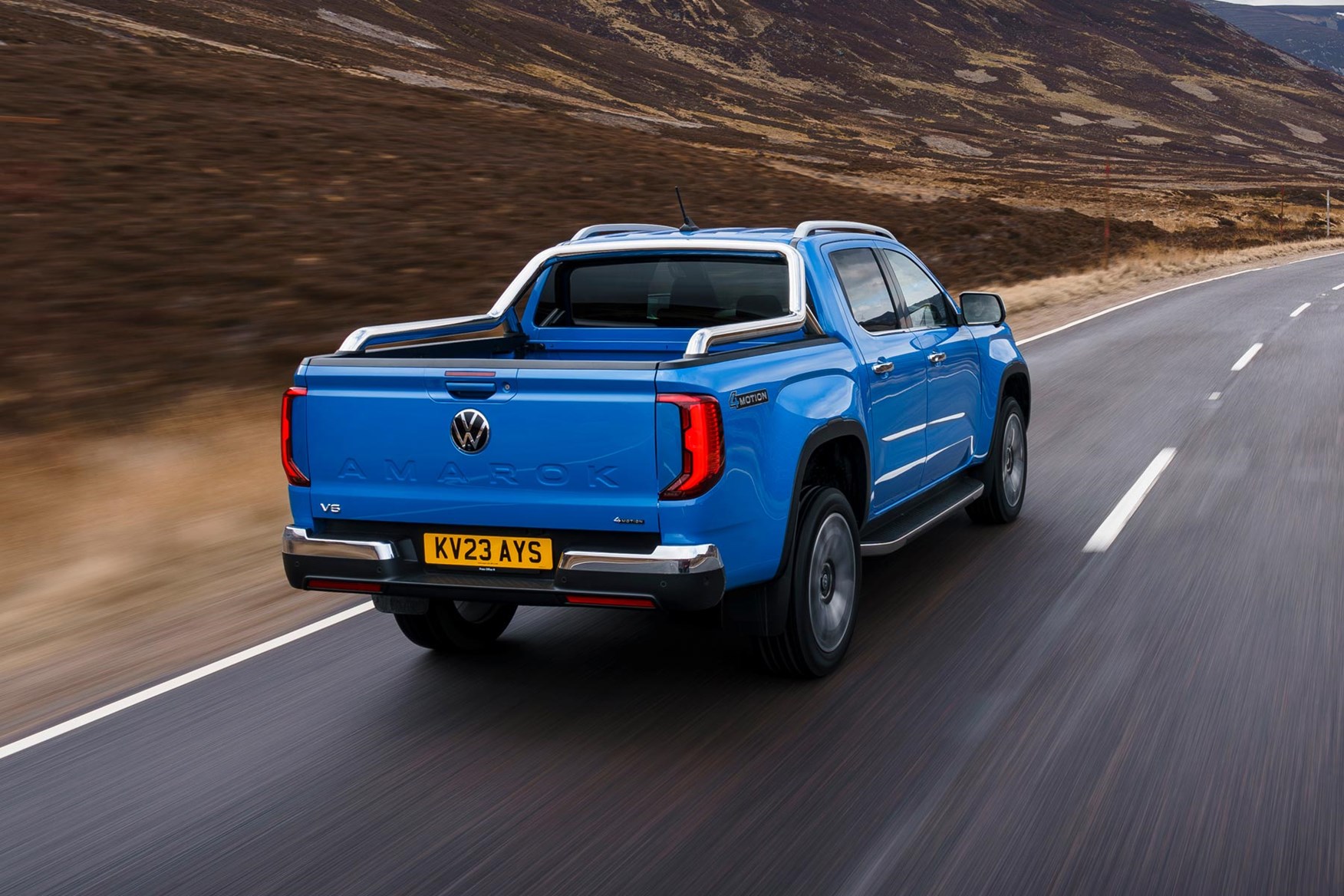
However modern a pickup truck gets inside, it is almost impossible to combine the ability to carry 1,000kg and offer a cossetting, smooth ride. The Amarok is no different in this regard, with it making you fully aware of the small bumps and lumps on the road surface, particularly while you are at lower speed and don't have anything in the loading bay. This is because the rear suspension uses traditional leaf springs rather than the sophisticated independent system on the newest Ford Ranger Raptor.
This remains true for the Aventura model, even with its lower payload, as it is the 21-inch wheels rather than the suspension that impacts the amount it can carry. The bad news is that increasing the wheel size of a pickup truck by three inches over the 18-inch or 17-inch rims offered on the rest of the range. These large wheels were inevitably going to have an impact on how it rides. A pickup teeters on the edge of a harsh ride anyway, and these large wheels tip it over the precipice. It is more apparent at town speeds than on faster roads, as it picks up every crack and bump and makes them apparent via the medium of your spine.
If you pick one of the other models in the range , the Amarok manages to be one of the best pickup trucks in terms of driving and handling.
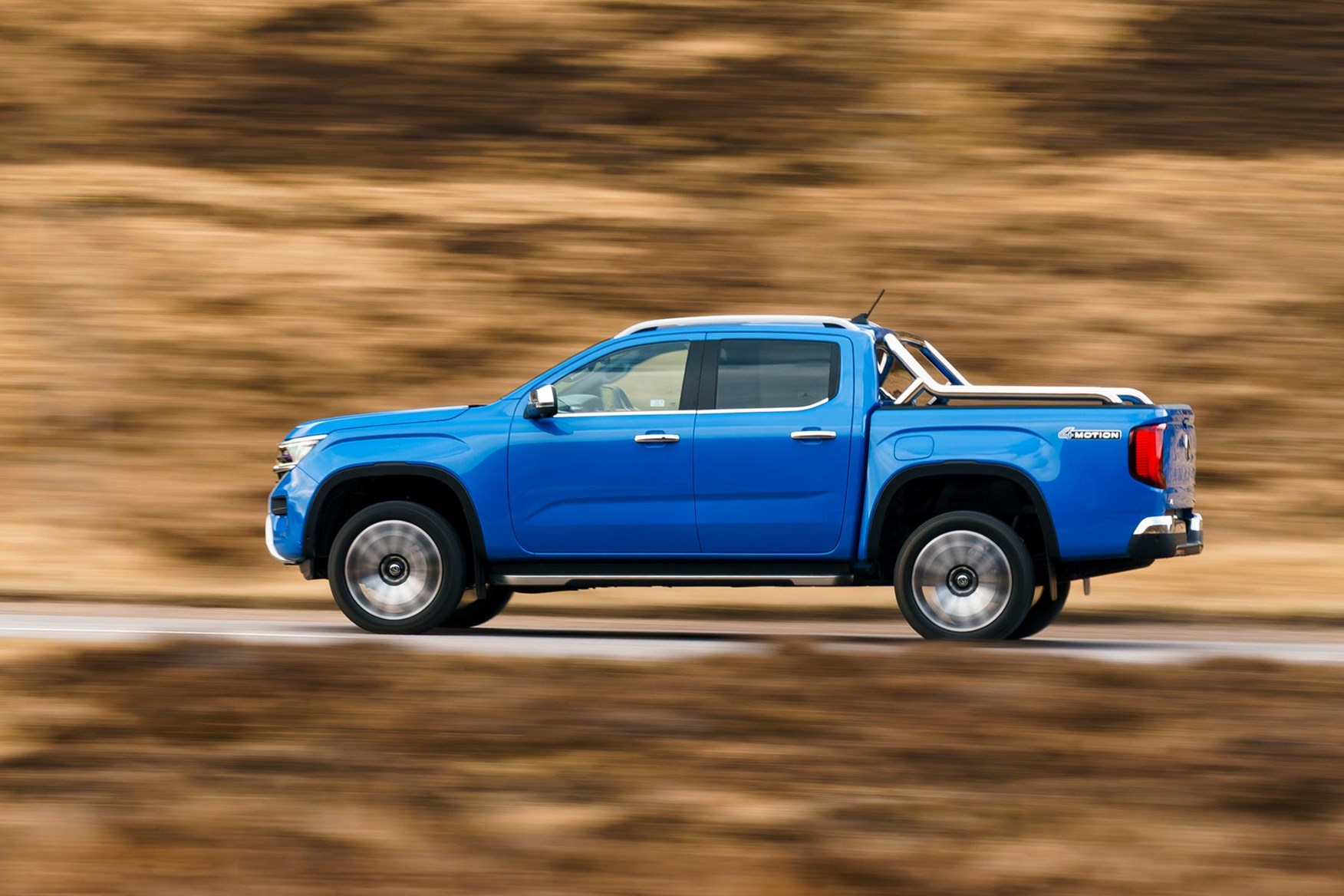
The rest of the driving experience is about as good as a large pickup truck can get - it is quiet and settled in a way that befits the SUV-like interior. Ignore that slightly agricultural ride and you really could be in a passenger car, albeit a really big one.
What is the Volkswagen Amarok like off road?
The off-road driving we have done, both in South Africa and in the UK, hasn't been that challenging by pickup standards, but the Amarok dispatched it with zero fuss. This could say something about the terrain and VW’s lack of risk taking when picking a route, or it could be that the Amarok is just supremely capable. We reckon it’s a mixture of both – the ability to flick into low-ratio four-wheel drive, lock the rear differential and activate hill-descent at a prod of a button meant that there was very little drama. The wading depth has been boosted to 800mm now, too, although the dry conditions we were out and about in didn't allow us to test that claim.
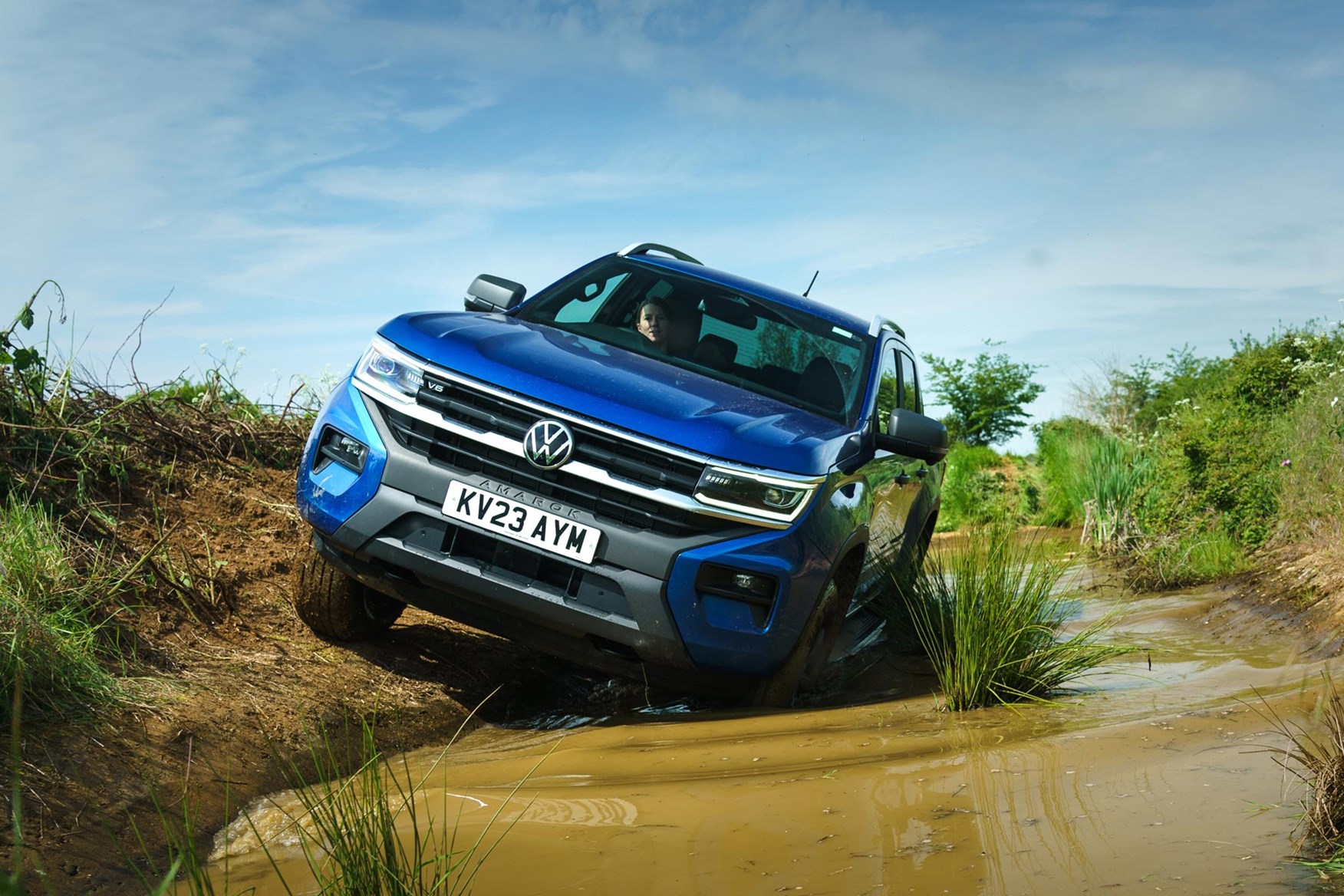
- Bespoke VW elements
- Ford provides the infotainment system
- Leather and posh materials aplenty
There isn't really a basic, entry-level version of the Amarok, with even the Life model coming with a decent level of attention to detail on the inside. This is the only version that gets basic cloth covering for the seats, though, but otherwise there is a large central screen and a digital cockpit - no suffering of physical needles here.
The cabin is another area where VW has been allowed to make things its own, and some of the features that you come into contact with regularly are very much the brand's own. The steering wheel, for example, and the door panels, which in higher trims have some lovely feeling coverings that raise the feeling of the interior.
There are also some features that are very much Ford, though - the gear shifter and the central screen are two notable ones.
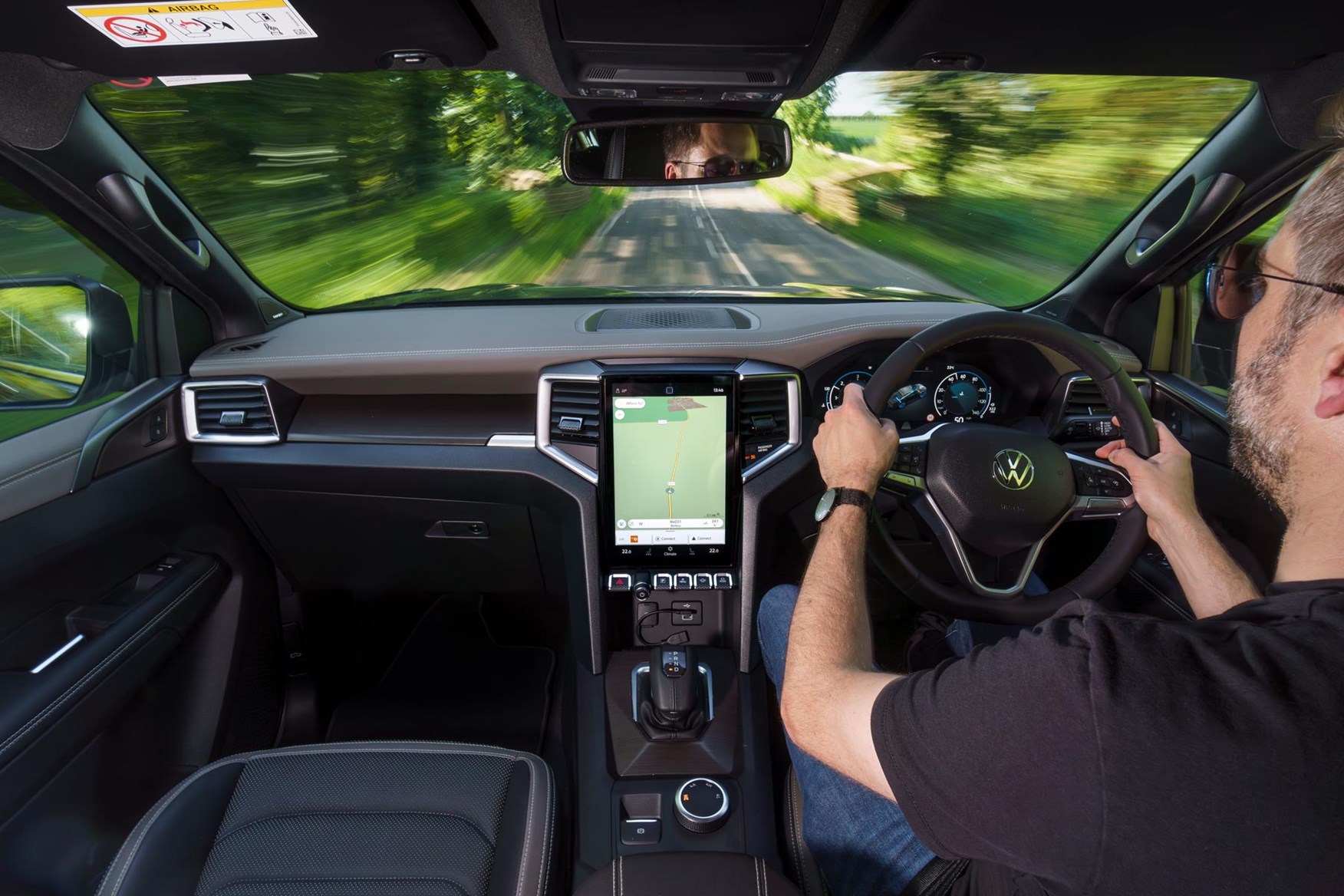
Thankfully for those who get frustrated with touch screens, the latter of these has some physical buttons below the screen that act as shortcuts to some of the more popular functions. Personally we would prefer to be able to control the heating system directly, but there is at least a shortcut button to get to that part of the menu.
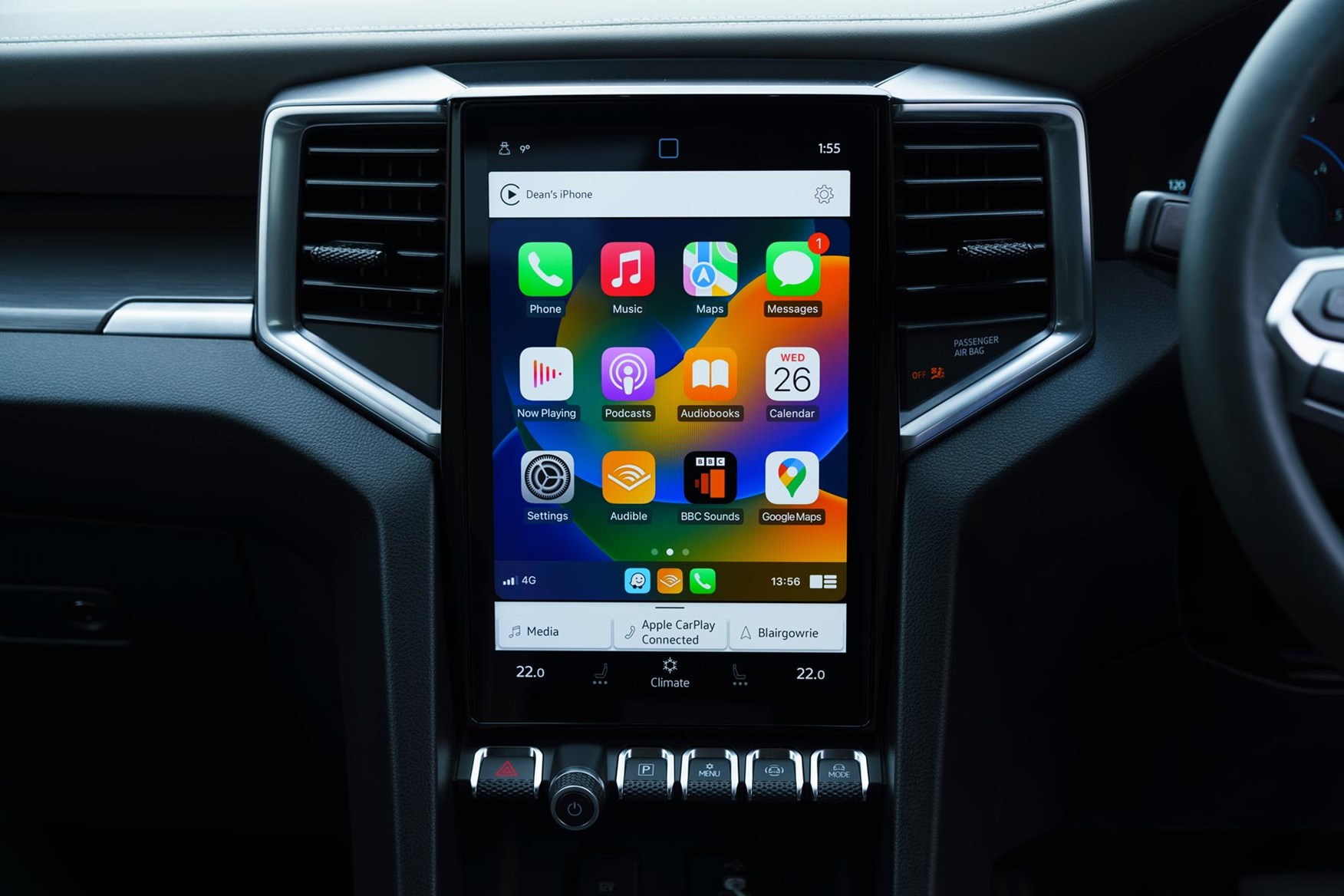
You will have to take your gloves off in the winter to adjust the temperature still, though. Mercifully, and best of all, there is a physical volume dial. Which is a vast improvement over the tactile controls on other modern VWs.
How much space is there in the 2023 Volkswagen Amarok?
The previous Amarok was ok for rear space, but this version has moved things on a bit. The rear seats still have a relatively upright back, but there is more legroom than before. There is a fraction more room in the front too, so there is enough for four adults to travel in comfort.
Space around the cabin is good, too, with a decent selection of cubby holes and a large bin in between the two front seats, and some large door bins. The automatic gearbox and electronic parking brake free up some room in the central console, but the driving-mode selector takes some space up. Swings and roundabouts. Regardless, there is still room for two cup holders, set relatively far back. Other than the conventional glovebox, there aren't any other storage areas around the cabin.
- Pricing starts at £33,000
- Four trims to choose from
- Only in double-cab form
The Volkswagen Amarok comes in a choice of four trims, Life, Style, PanAmericana and Aventura. There is less choice when it comes to body styles, though, as all four only come in double-cab form. This means there is no budget entry-level single-cab version that brings the price down.
As a result, the lowest priced Amarok starts from £33,000 (not including VAT) with all four versions coming with a decent amount of equipment.
Volkswagen Amarok mpg
The three engine options in the VW Amarok range are all in the same sort of ballpark when it comes to fuel economy. The most efficient is the Amarok Life with the 170hp 2.0-litre diesel and the manual gearbox - this has a best combined official figure of 33.6mpg.
The rest of the range are all automatics. The 2.0-litre 205hp offers between 32.1mph and 32.8mpg depending on which trim you go for, while the 3.0-litre diesel manages 28.0mpg regardless of which model you get.
Volkswagen Amarok servicing
The servicing prospect for the Amarok is boosted by the fact that you get the '5+ Promise' included as standard. This means you get five years cover included, which covers three oil change services, two oil change and inspection and three MOTs.
Volkswagen Amarok warranty
The 5+ Promise also brings about five years warranty, which is an increase over the standard three years' cover. There is also five years of roadside assistance.
Volkswagen Amarok Life standard equipment
- 17-inch alloy wheels
- LED headlights
- 10-inch infotainment screen
- Rear-view camera system
Volkswagen Amarok Style standard equipment
- 18-inch alloy wheels
- Chrome styling bar
- Black side steps with chrome insert
- 12-inch infotainment screen
- Satellite navigation
- 360-degree around-view camera
Volkswagen Amarok PanAmericana standard equipment
The PanAmericana focuses on off-road ability, so gets kit centred on that.
- Rear locking differential
- Underbody protection
- comfort suspension
- 18-inch black alloy wheels
- Upgraded bumper with black detailing
Volkswagen Amarok Aventura standard equipment
The Aventura trim is more design focused, so gets more exterior upgrades.
- 21-inch alloy wheels
- Chrome-plated door mirrors and door handles
- Upgraded bumper with silver detailing
How much does the 2023 Volkswagen Amarok cost?
The Life trim is the cheapest in the Volkswagen Amarok range, and starts at £33,000 (not including VAT). The step up to Style is a notable one, as it adds £8,450 to the price.
Heading up to PanAmericana is less of a jump, but it is still relatively hefty at £4,750. Aventura is less of a leap still, as that adds £800 to the PanAmericana.
The basic Life trim is the only one to come with the six-speed manual gearbox as standard and the 10-speed automatic will add £1,300 to the price. The other trims all come with the auto 'box as standard.
Sharing engines and gearboxes, both established and well tested, with Ford will help VW's quest for reliability. These engines power hundreds of thousands of vans and trucks, and have a strong reputation.
It's quite early to be able to make a call on the Amarok's reliability in and of itself, but the 10-speed gearboxes have featured in plenty of commercial and passenger vehicles in Ford's range, so they have been tried and tested too.
- 20 safety assistance systems
- Many come as standard
- CV-specific speed limit readout
The Amarok was put through the Euro NCAP crash test and came away with the full five stars. This is thanks in part to a wide array of safety and assistance systems, including the new intelligent speed assist and lane assist pro.
You have to step up to Style trim to get most of these features, with the adaptive cruise control, lane keep assist, around-view camera and park assist all coming at this stage.
One excellent feature is the speed limit readout, on the digital display in front of the steering wheel. It gives you the commercial vehicle specific speed, rather than the national speed limit for cars. A handy little extra bit of assistance that could keep you below the legal maximum.
Which Volkswagen Amarok is best for me?
There might be four models in the Amarok range, but two of them will take up the lion's share of the sales and are the pick of the range.
Given the Amarok's overall focus on luxury and premium features in the cabin, there seems little point in going for the Life model - if you want a workhorse there are cheaper alternatives out there.
The Aventura at the other end of the Amarok's range makes even less sense, though. Because it misses out on the crucial 1,000kg payload, it doesn't qualify for the crucial tax breaks that make pickup trucks so attractive. The 21-inch wheels that are its USP are detrimental to the overall experience, too - the negative impact on the ride outweighs the visual upgrade. Ultimately, why spend so much more on the purchase price when the PanAmericana offers the same but with slightly smaller wheels? This, complete with its 3.0-litre diesel, is where the Amarok makes most sense and is where our money would go.



















